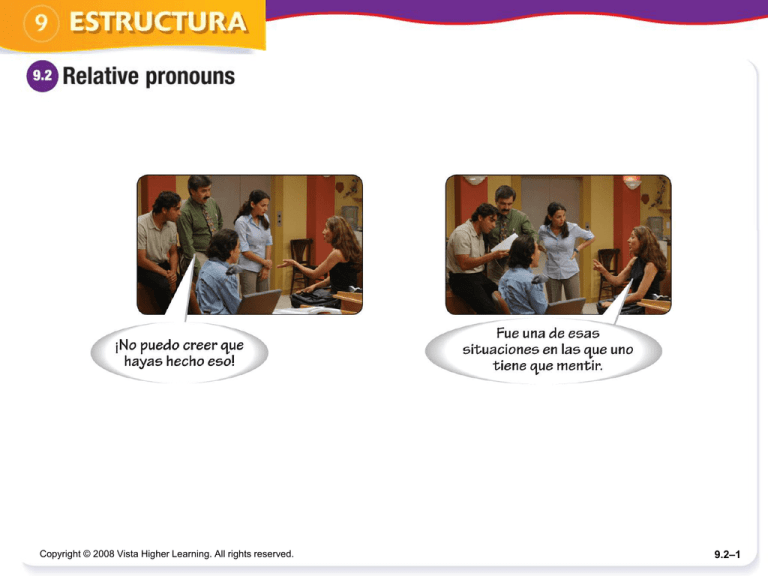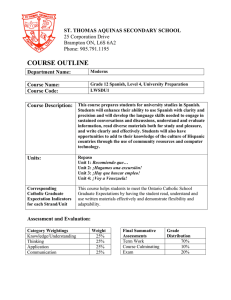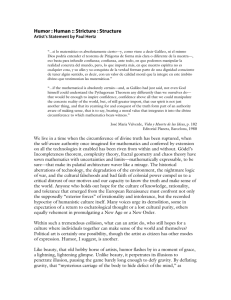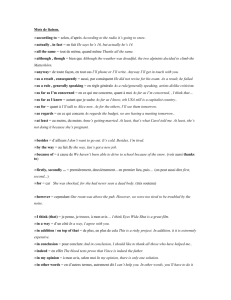
Copyright © 2008 Vista Higher Learning. All rights reserved.
9.2–1
Relative pronouns are used to connect short sentences or clauses
in order to create longer, smoother sentences. Unlike the
interrogative words qué, quién(es), and cuál(es), relative pronouns
never have accent marks.
Copyright © 2008 Vista Higher Learning. All rights reserved.
9.2–2
The relative pronoun que
• Que (that, which, who) is the most frequently used
relative pronoun (pronombre relativo). It can refer to
people or things, subjects or objects, and can be used
in restrictive clauses (no commas) or nonrestrictive
clauses (with commas). Note that although some
relative pronouns may be omitted in English, they
must always be used in Spanish.
Copyright © 2008 Vista Higher Learning. All rights reserved.
9.2–3
El reportaje que vi ayer me hizo cambiar de opinión sobre la guerra.
The report (that) I saw last night made me change my opinion about the war.
Las primeras diez personas que respondan correctamente ganarán una
suscripción gratuita.
The first ten people who respond correctly will win a free subscription.
El desastre fue causado por la lluvia, que ha durado más de dos semanas.
The disaster was caused by the rain, which has lasted over two weeks.
Copyright © 2008 Vista Higher Learning. All rights reserved.
9.2–4
El/La que
• After prepositions, que is used with the definite article: el que,
la que, los que, or las que. The article must agree in gender
and number with the thing or person it refers to (the antecedent).
When referring to things (but not people), the article may be
omitted after short prepositions, such as en, de, and con.
Los periódicos para los que escribo son independientes.
The newspapers I write for are independent. (Lit: for which I write)
El edificio en (el) que viven es viejo.
The building they live in is old.
La fotógrafa con la que trabajo ganó varios premios.
The photographer with whom I work won several awards.
Copyright © 2008 Vista Higher Learning. All rights reserved.
9.2–5
• El que, la que, los que, and las que are also used for
clarification in nonrestrictive clauses (with commas) when it
might be unclear to what or whom the clause refers.
Hablé con los empleados de la compañía, los que están
contaminando el río.
I spoke with the employees of the company, the ones who are
polluting the river.
Hablé con los empleados de la compañía, la que está contaminando
el río.
I spoke with the employees of the company, (the one) which is
polluting the river.
Copyright © 2008 Vista Higher Learning. All rights reserved.
9.2–6
El/La cual
• El cual, la cual, los cuales, and las cuales are
generally interchangeable with el que, la que, los que,
and las que. They are often used in more formal speech
or writing. Note that when el cual and its forms are used,
the definite article is never omitted.
El edificio en el cual se encuentra la emisora de radio es viejo.
The building in which the radio station is located is old.
La revista para la cual trabajo es muy influyente.
The magazine for which I work is very influential.
Copyright © 2008 Vista Higher Learning. All rights reserved.
9.2–7
In everyday Spanish, en que and en el/la cual are often replaced
by donde.
La casa donde vivo es muy grande.
La Universidad donde estudio es muy prestigiosa.
Copyright © 2008 Vista Higher Learning. All rights reserved.
9.2–8
Quien/Quienes
• Quien (singular) and quienes (plural) are used to refer
only to people, not to things. Quien(es) is generally
interchangeable with forms of el que and el cual.
Los investigadores, quienes (los que/los cuales) estudian los medios
de comunicación, son del Ecuador.
The researchers, who are studying mass media, are from Ecuador.
El investigador de quien (del que/del cual) hablaron era mi profesor.
The researcher about whom they spoke was my professor.
Copyright © 2008 Vista Higher Learning. All rights reserved.
9.2–9
When used with a or de, the contractions al que/cual and del
que/cual are formed.
Copyright © 2008 Vista Higher Learning. All rights reserved.
9.2–10
• Although que and quien(es) may both refer to people,
their use depends on the structure of the sentence.
• In restrictive clauses (no commas) that refer to people,
que is used if no preposition is present. If a preposition
or the personal a is present, quien (or el que/el cual)
is used instead. Below, que is equivalent to who, while
quien expresses whom.
La gente que mira televisión está harta de las cadenas sensacionalistas.
The people who watch TV are tired of sensationalist networks.
Esperamos la respuesta de los politicos a quienes (a los que/a los cuales)
queremos entrevistar.
We’re waiting for a response from the politicians (whom) we want to interview.
Copyright © 2008 Vista Higher Learning. All rights reserved.
9.2–11
• In nonrestrictive clauses (with commas) that refer to
people, quien (or el que/el cual) is generally used,
not que.
Juan y María, quienes trabajan conmigo, escriben la sección deportiva.
Juan and María, who work with me, write the sports section.
Copyright © 2008 Vista Higher Learning. All rights reserved.
9.2–12
In everyday Spanish, the formal rules for using relative
pronouns are not always followed.
Formal:
Los estudiantes de los cuales hablamos...
Informal:
Los estudiantes de que hablamos...
Formal:
La mujer a quien conocí ayer...
Informal:
La mujer que conocí ayer...
Copyright © 2008 Vista Higher Learning. All rights reserved.
9.2–13
The relative adjective cuyo
• The relative adjective cuyo (cuya, cuyos, cuyas)
means whose and agrees in number and gender with
the noun it precedes. Remember that de quién(es),
not cuyo, is used in questions to express whose.
El equipo periodístico, cuyo proyecto aprobaron, viajará en febrero.
The team of reporters, whose project they approved, will travel in February.
La fotógrafa Daniela Pérez, cuyas fotos anteriores ganaron muchos
premios, los acompañará.
Photographer Daniela Pérez, whose earlier photos won many awards, will
go with them.
Copyright © 2008 Vista Higher Learning. All rights reserved.
9.2–14





